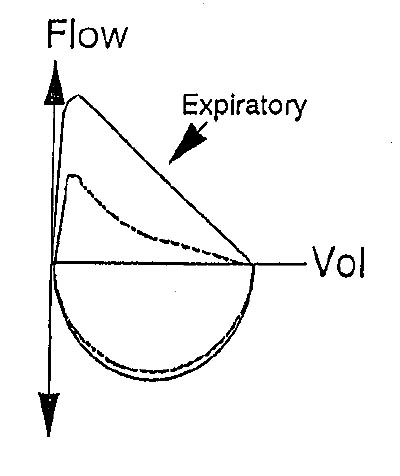10 Random Questions
A 2-year-old child has cardiac arrest during an inguinal herniorrhaphy under general anesthesia administered during a Jackson-Rees system. The graph shows end-tidal PCO2 monitored from the tip of the endotracheal tube during cardiopulmonary resuscitation; minute ventilation is unchanged. Which of the following is the most likely cause of the change beginning at the arrow?

- (A) Decreased fresh gas flow
- (B) Inadequate chest compression
- (C) Increased dead space
- (D) Restoration of cardiac output
- (E) Sampling artifact
A 30-kg patient with asthma is receiving general anesthesia and being mechanically ventilated with a measured tidal volume of 300 mL. Increasing the fresh gas flow from 3 L/min to 9 L/min without changing the ventilatory rate or I:E ratio will result in
- (A) decreased physiologic dead space
- (B) increased delivered tidal volume
- (C) increased end-expired carbon dioxide
- (D) unchanged delivered minute volume
- (E) unchanged peak inspiratory pressure
During therapy for eclampsia, toxic blood levels of magnesium sulfate can be distinguished from therapeutic levels by the presence of
- (A) diminished knee jerk reflex
- (B) a widened QRS complex on EKG
- (C) fetal tachycardia
- (D) maternal drowsiness
- (E) uterine rigidity
A 4-year-old child has just undergone a one-hour tonsillectomy with a volatile anesthetic, nitrous oxide, and oxygen. Which of the following will result in the most rapid emergence?
- (A) Decreased PaCO2
- (B) Increased cardiac output
- (C) Increased fresh gas flow
- (D) Increased solubility of the volatile agent
- (E) Presence of a ventricular septal defect
When compared with diazepam, midazolam
- (A) metabolites contribute more significantly to the sedative effect
- (B) elimination is less dependent on hepatic metabolism
- (C) has more predictable action after intramuscular administration
- (D) produces less respiratory depression
- (E) produces less hypotension during induction of anesthesia with opioids
If the low-pressure alarm of an anesthesia circuit is broken, which of the following monitors will provide the earliest indication of a disconnected ventilator hose?
- (A) Fail-safe system
- (B) Infrared capnograph
- (C) Nitrogen analyzer
- (D) Oxygen analyzer
- (E) Pulse oximeter
Which of the following complications is more likely to occur during cannulation of the left internal jugular vein than during cannulation of the right internal jugular vein?
- (A) Injury to the thoracic duct
- (B) Injury to the recurrent laryngeal nerve
- (C) Injury to the phrenic nerve
- (D) Perforation of the esophagus
- (E) Pneumothorax
Which of the following fluids will restore circulating blood volume with the smallest infused volume?
- (A) Albumin 25%
- (B) Dextrose 5% in saline solution 0.45%
- (C) Hydroxyethyl starch 6%
- (D) Lactated Ringer's solution
- (E) Type-specific whole blood
The illustration depicts flow-volume loops for the same person at two different times in his life. Which of the following is indicated by the dotted loop?

- (A) Bronchial tumor
- (B) Chronic asthmatic bronchitis
- (C) Morbid obesity
- (D) Paralysis of a vocal cord
- (E) Subglottic stenosis
A patient with metastatic carcinoma and chronic renal failure has tremors, fasciculations, mydriasis, and hyperreflexia after several days of therapy with high doses of meperidine for analgesia. Which of the following is most likely to occur if the meperidine is continued?
- (A) Disappearance of the symptoms as tolerance to meperidine develops
- (B) Pinpoint constriction of pupils
- (C) Progressive hypothermia
- (D) Progressive sedation from meperidine toxicity
- (E) Seizures from normeperidine toxicity